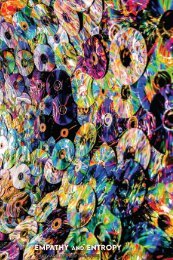LWRS June 2020 Volume 1, Issue 1
Inaugural Issue co-edited by Yndalecio Isaac Hinojosa and Isabel Baca
Inaugural Issue co-edited by Yndalecio Isaac Hinojosa and Isabel Baca
Create successful ePaper yourself
Turn your PDF publications into a flip-book with our unique Google optimized e-Paper software.
Ana M. Cortés Lagos<br />
Social and Institutional Context<br />
Several related social transformations took place in the Chilean educational landscape<br />
during the first decade of the 2000s: an expansion of the middle class and a broadening<br />
of high school education coverage produced an increase in access to the university<br />
(Neira, 2004). At the same time, in response to this expansion and diversification in<br />
the student population in higher education, there was a sudden growth in the number<br />
of higher education institutions. Indeed, this expansion in access to the university is<br />
documented often by publications dealing with the emergence and development of<br />
the PLEA writing program (Ávila Reyes, González-Alvarez, & Castillo, 2013; Sánchez<br />
& Montes, 2016). These changes are also discussed by Hernán Neira (2004):<br />
Most of these new students have arrived at higher education due to an expansion of<br />
the high-school education coverage that reached 90% in 2000, in an average of 10<br />
years. Though the wealthiest quintile is still the most relevant user of college<br />
education, the rise in student population is due mainly to the fact that the second,<br />
third, and even fourth quintiles are now candidates to university. 3 (par. 10)<br />
Now, broadening access to higher education and the increase in student population<br />
diversity all imply positive transformations, but the way this process unfolded in Chile<br />
is not altogether unproblematic. As Neira and other writers (Cruz-Coke, 2004;<br />
Redondo, 2005) suggest, these new students were not harmoniously integrated into<br />
the university system in a way that produced the equal access to education that would<br />
be expected from such an expansion. Rather, the response to this sudden growth in<br />
the demand for higher education emerged from actors that radically changed the logics<br />
and dynamics of the provision of education: “a generation of businessmen with the<br />
capacity to create universities, supported by power groups and access to capital,”<br />
according to Neira (2004, par. 8). 6 These capitalists were not necessarily motivated by<br />
profit, but by an interest to promote their own conservative ideologies. Thus, most of<br />
these non-traditional students that arrived at the university did so on the “margins” of<br />
the system, so to speak.<br />
Understanding the demands that emerged with the expansion of access to<br />
university requires a brief explanation regarding the larger context of Chilean higher<br />
education. Chilean higher education institutions can be grouped roughly into two<br />
groups: those that belong to the Consejo de Rectores and those that do not. The<br />
organization Consejo de Rectores de las Universidades Chilenas (CRUCH or Counsel<br />
of Rectors of Chilean Universities) was created in 1954 and was designated to<br />
<strong>LWRS</strong>, <strong>2020</strong>, 1(1) | 100





